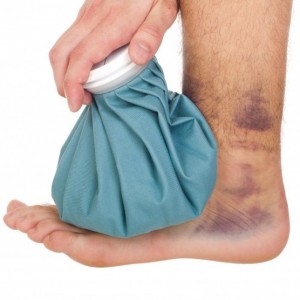 Ankle and foot injuries are a part of living an active lifestyle. You’ll probably have a few bumps and bruises after athletic activity or while training for a marathon, but what separates natural soreness from an acute injury? Today, we share five different ways you can diagnose a foot and ankle injury.
Ankle and foot injuries are a part of living an active lifestyle. You’ll probably have a few bumps and bruises after athletic activity or while training for a marathon, but what separates natural soreness from an acute injury? Today, we share five different ways you can diagnose a foot and ankle injury.
Diagnosing Foot and Ankle Injuries
If you notice any of the below signs, it may be an indication that there’s more to your pain than meets the eye. Here are five signs of an ankle or foot injury.
1. Discoloration – One of the easiest ways to spot an injury is to look for physical signs. You might tweak your ankle during a lacrosse game and be slightly hobbled the rest of the game, but usually symptoms resolve in a day or two. On the flip side, a serious sprain or a break will involve some heavy swelling and bruising. If your foot is discolored or has swelled up, odds are you are dealing with an underlying injury.
2. The Pain Scale – Pain is the body’s natural way of telling us that it is in a state of discomfort. Using a pain scale of 1-10, with 10 being extreme pain, categorize your pain. If you’re in a lot of pain, you probably have an injury, while smaller numbers indicate soreness or minor issues that typically resolve in a few days. If you’re in the middle of the scale, track your pain for a few days. If it gets worse or fails to decrease, you should be examined for an injury.
3. Type of Pain – Pain comes in a number of different forms. There’s dull pain, shooting pain, pain that worsens with activity, pain that goes in waves, etc. Muscle soreness is typically categorized by dull pain that increases slightly with activity. If you’re dealing with shooting pain when running/standing, or other symptoms like numbness or a burning sensation, you’re likely dealing with an injury.
4. Inhibited Movement – Range of motion tests can help pinpoint if you’re dealing with normal pain from a stubbed toe or if you fractured a bone. If you can’t flex or bend your toe, it can be a sign that there’s more to the problem than meets the eye. You might experience some mild to moderate discomfort when conducting range of motion tests, but if movement is severely inhibited or you suffer from shooting pain while flexing, you may be dealing with a break.
5. Doctor Confirmation – The most straightforward approach to determine if your pain is coming from an injury or from general soreness is by visiting an ankle and foot specialist. They’ll be able to conduct a physical exam and imaging tests to look for damage to the bones, ligaments or other foot structures. Not only can they diagnose your pain, but they can set you up with a treatment plan get past your pain!